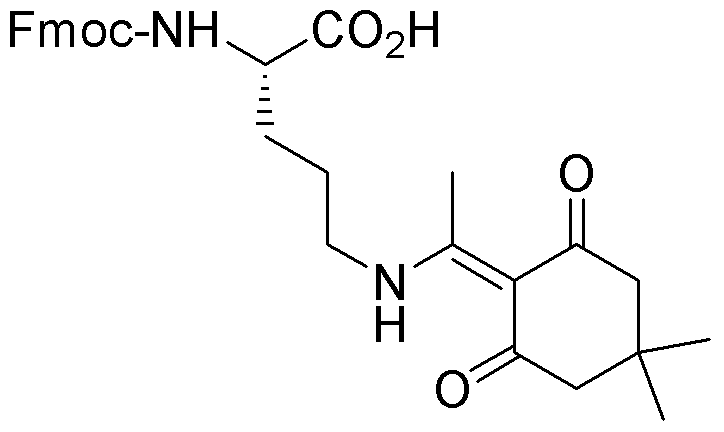Na-Fmoc-Nd-[1-(4,4-dimethyl-2,6-dioxocyclohexylidene)ethyl-L-ornithine is widely utilized in research focused on:
- Peptide Synthesis: This compound is commonly used as a protecting group in peptide synthesis, allowing for the selective modification of amino acids without affecting the overall structure. This is crucial for creating complex peptides in pharmaceutical research.
- Drug Development: Its unique structure makes it valuable in the design of novel therapeutic agents, particularly in oncology, where targeted drug delivery systems are essential for improving treatment efficacy.
- Bioconjugation: The compound can be employed in bioconjugation processes, linking biomolecules to create targeted therapies or diagnostic agents, enhancing the precision of drug delivery.
- Research in Neuroscience: It is used in studies related to neuropeptides, contributing to the understanding of neurological functions and potential treatments for neurodegenerative diseases.
- Material Science: The compound's properties are explored in the development of novel materials, particularly in creating smart drug delivery systems that respond to specific stimuli, improving patient outcomes.
General Information
Properties
Safety and Regulations
Applications
Na-Fmoc-Nd-[1-(4,4-dimethyl-2,6-dioxocyclohexylidene)ethyl-L-ornithine is widely utilized in research focused on:
- Peptide Synthesis: This compound is commonly used as a protecting group in peptide synthesis, allowing for the selective modification of amino acids without affecting the overall structure. This is crucial for creating complex peptides in pharmaceutical research.
- Drug Development: Its unique structure makes it valuable in the design of novel therapeutic agents, particularly in oncology, where targeted drug delivery systems are essential for improving treatment efficacy.
- Bioconjugation: The compound can be employed in bioconjugation processes, linking biomolecules to create targeted therapies or diagnostic agents, enhancing the precision of drug delivery.
- Research in Neuroscience: It is used in studies related to neuropeptides, contributing to the understanding of neurological functions and potential treatments for neurodegenerative diseases.
- Material Science: The compound's properties are explored in the development of novel materials, particularly in creating smart drug delivery systems that respond to specific stimuli, improving patient outcomes.
Documents
Safety Data Sheets (SDS)
The SDS provides comprehensive safety information on handling, storage, and disposal of the product.
Product Specification (PS)
The PS provides a comprehensive breakdown of the product’s properties, including chemical composition, physical state, purity, and storage requirements. It also details acceptable quality ranges and the product's intended applications.
Certificates of Analysis (COA)
Search for Certificates of Analysis (COA) by entering the products Lot Number. Lot and Batch Numbers can be found on a product’s label following the words ‘Lot’ or ‘Batch’.
*Catalog Number
*Lot Number
Certificates Of Origin (COO)
This COO confirms the country where the product was manufactured, and also details the materials and components used in it and whether it is derived from natural, synthetic, or other specific sources. This certificate may be required for customs, trade, and regulatory compliance.
*Catalog Number
*Lot Number
Safety Data Sheets (SDS)
The SDS provides comprehensive safety information on handling, storage, and disposal of the product.
DownloadProduct Specification (PS)
The PS provides a comprehensive breakdown of the product’s properties, including chemical composition, physical state, purity, and storage requirements. It also details acceptable quality ranges and the product's intended applications.
DownloadCertificates of Analysis (COA)
Search for Certificates of Analysis (COA) by entering the products Lot Number. Lot and Batch Numbers can be found on a product’s label following the words ‘Lot’ or ‘Batch’.
*Catalog Number
*Lot Number
Certificates Of Origin (COO)
This COO confirms the country where the product was manufactured, and also details the materials and components used in it and whether it is derived from natural, synthetic, or other specific sources. This certificate may be required for customs, trade, and regulatory compliance.


